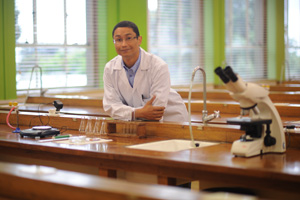Hard work pays off for Hattas
13 September 2012 | Story by Newsroom Rewriting the book: Dawood Hattas has come up with some interesting findings in his doctoral research, as recognised by a recent poster award.
Rewriting the book: Dawood Hattas has come up with some interesting findings in his doctoral research, as recognised by a recent poster award.
Juggling work and studies has never been easy, more so if you're doing a research-intensive doctorate.
But Dawood Hattas, chief scientific officer in UCT's Department of Botany, appears to have managed well. So much so that his work for his PhD on plant chemical defences won the best poster presentation award - his first - at the recent annual conference of the Grassland Society of Southern Africa.
At the event, hosted in Langebaan, Hattas gave a paper and a poster presentation on his research, his poster titled Using an Appropriate Condensed Tannin Standard?
In this work, he investigated the appropriateness of the often used and commercially available quebracho tannin as the standard in quantifying condensed tannins in Africa savannah tree species, as opposed to using sorghum and absolute tannin.
Condensed tannins are present in most plants and is the substance that gives tea its colour and astringency. But sometimes it forms insoluble bonds with protein, making the protein in plants unavailable for digestion by certain herbivores like goats, kudu and impala. Consequently, if present in high enough quantities, the tannin may decrease the food quality for these animals.
The problem is that scientists, who need to accurately determine the condensed tannin concentration in these foods, often use tannin found in quebracho trees - more commonly found in South America - as the yardstick.
Hattas' findings would suggest it's time to rethink that strategy.
"We found that Quebracho is grossly inappropriate - overestimating condensed tannins by as much as eight times - which questions previous findings of forage quality estimates where this standard was used."
 This work is licensed under a Creative Commons Attribution-NoDerivatives 4.0 International License.
This work is licensed under a Creative Commons Attribution-NoDerivatives 4.0 International License.
Please view the republishing articles page for more information.










